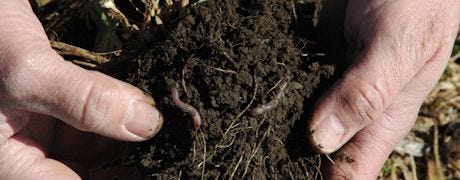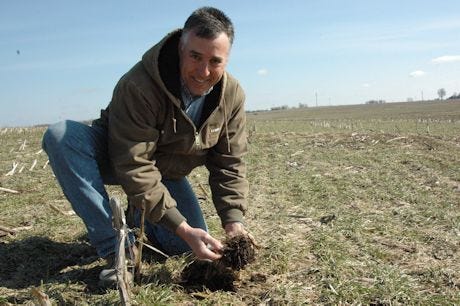
Walking through Eddie Weinreich's fields and there are visible remnants of a corn crop. Small stalks still poke through a stand of rye. It is all part of his no-till and cover crop field trial at his Saline County farm.
He started by planting a three-way blend of annual rye grass, crimson clover and radishes. "I learned at the seminars that you cannot plant a single species and find good results," he says. "It takes more than one."

NATURAL TILLAGE: Earthworms abound in a no-till and cover crop farm just outside of Marshall. Eddie Weinreich says it is proof that the soil is healthy.
That is music to the ears of long-time no-till, cover crop guru David Brandt. Brandt plants up to a 10-way mix at his Ohio farm. "In 1978, we planted single species covers because we didn't know any different," Brandt says. "But we have learned our lesson. More is better." His mixes can include rye, hairy vetch, Austrian winter pea, radishes, buckwheat, phacelia, sunflower, oats, and Ethiopian cabbage.
What Weinreich is realizing is that each variety of cover crops offers a different benefit for the soil.
A tiling system
In his operation, Brandt finds annual rye and radishes help improve water infiltration. "This is what we use to loosen the soil on our farms and the farms we rent that we can't have underground drains put in," he explains.
As the plant grows, its roots create channels and crevices in the soil. This allows for both air and water movement. According to Ohio State University Extension researchers, found that the bare soil that has been tilled has the ability to hold 1.5 to 1.7 inches of water, while continuously vegetated soil has the ability to hold 4.2 to 4.5 inches of water.~~~PAGE_BREAK_HERE~~~

RICH SOIL: Eddie Weinreich finds himself knee-deep in black dirt on his Saline County farm. He is using a combination of cover crops and no-till farming practices to improve soil health.
While radishes are known for breaking up the soil whereby enhancing water movement, he says farmers need to plant them in a mix, preferably with winter peas. When placed alongside winter peas, the radishes pulled the nitrogen from the peas and the tuber extended 21 inches deep. "The tap root went an additional 36 inches deep," Brandt explains. "That is why I say, this is my tiling system in my soils."
A nutrient system
Last year, Brandt stopped putting any nitrogen on his fields in southern Ohio. Instead, he relied on hairy vetch. He plants it at a seeding rate of 12 pounds per acre. "That hairy vetch produced 236 pounds of nitrogen (per acre)," Brandt exclaims.
His cover crop of choice for nitrogen fixation is the cool-season, annual legume known as Austrian winter peas. Brandt sows these at a rate of 30 pounds per acre. Taking a deeper look into the soil, he found nodulation at 1 ½ inches deep, right where he plants his corn. However, even at depths of 3 to 4 inches there was 90% nodulation. "We found nodulation all the way to 10 inches," he adds.
"It takes management to incorporate cover crops in a row crop system," Weinreich says. "You need to know what you are planting and why. Just because it worked on other farms, it may not work on your farm. You have to be willing to try new things."
Ultimately, the results are in farmer testimonials. Brandt purchased his grandfather's farm of clay based, yellow soil in 1972. At that time, it had an organic matter content of 0.5%. This last year the organic reading was 7.5%. "Our wood lot that has never been farmed is 6.5%," he says. "I never thought we would pass the organic matter on that wood lot. How high can we go? I just don't know."
About the Author(s)
You May Also Like






